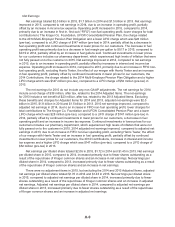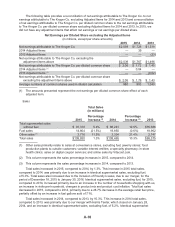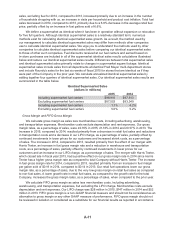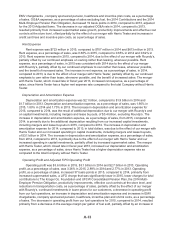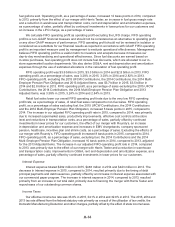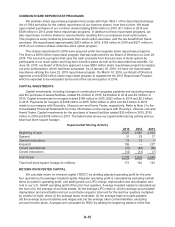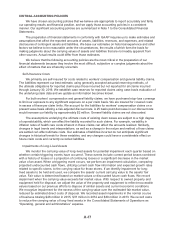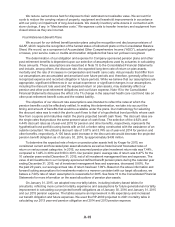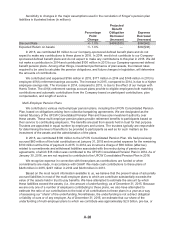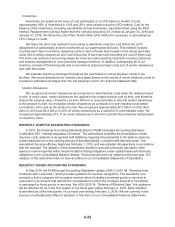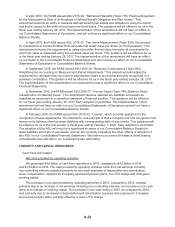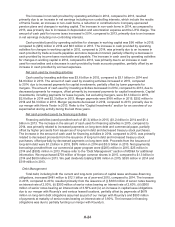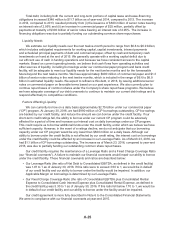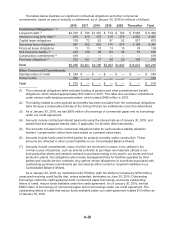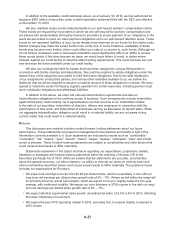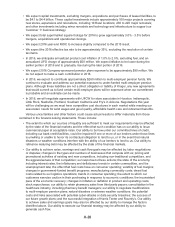Kroger 2015 Annual Report Download - page 92
Download and view the complete annual report
Please find page 92 of the 2015 Kroger annual report below. You can navigate through the pages in the report by either clicking on the pages listed below, or by using the keyword search tool below to find specific information within the annual report.A-18
The factors that most significantly affect the impairment calculation are our estimates of future
cash flows. Our cash flow projections look several years into the future and include assumptions on
variables such as inflation, the economy and market competition. Application of alternative assumptions
and definitions, such as reviewing long-lived assets for impairment at a different level, could produce
significantly different results.
Goodwill
Our goodwill totaled $2.7 billion as of January 30, 2016. We review goodwill for impairment in the
fourth quarter of each year, and also upon the occurrence of triggering events. We perform reviews of
each of our operating divisions and variable interest entities (collectively, “reporting units”) that have
goodwill balances. Fair value is determined using a multiple of earnings, or discounted projected future
cash flows, and we compare fair value to the carrying value of a reporting unit for purposes of identifying
potential impairment. We base projected future cash flows on management’s knowledge of the current
operating environment and expectations for the future. If we identify potential for impairment, we measure
the fair value of a reporting unit against the fair value of its underlying assets and liabilities, excluding
goodwill, to estimate an implied fair value of the reporting unit’s goodwill. We recognize goodwill
impairment for any excess of the carrying value of the reporting unit’s goodwill over the implied fair value.
In 2015, goodwill increased $420 million primarily due to our merger with Roundy’s. In 2014,
goodwill increased $169 million primarily due to our merger with Vitacost.com. For additional information
related to the allocation of the purchase price for Roundy’s and Vitacost.com, refer to Note 2 to the
Consolidated Financial Statements.
The annual evaluation of goodwill performed for our other reporting units during the fourth quarter of
2015, 2014 and 2013 did not result in impairment. Based on current and future expected cash flows, we
believe goodwill impairments are not reasonably likely. A 10% reduction in fair value of our reporting units
would not indicate a potential for impairment of our goodwill balance.
For additional information relating to our results of the goodwill impairment reviews performed
during 2015, 2014 and 2013 see Note 3 to the Consolidated Financial Statements.
The impairment review requires the extensive use of management judgment and financial estimates.
Application of alternative estimates and assumptions, such as reviewing goodwill for impairment at a
different level, could produce significantly different results. The cash flow projections embedded in our
goodwill impairment reviews can be affected by several factors such as inflation, business valuations in
the market, the economy and market competition.
Store Closing Costs
We provide for closed store liabilities on the basis of the present value of the estimated remaining
non-cancellable lease payments after the closing date, net of estimated subtenant income. We estimate
the net lease liabilities using a discount rate to calculate the present value of the remaining net rent
payments on closed stores. We usually pay closed store lease liabilities over the lease terms associated
with the closed stores, which generally have remaining terms ranging from one to 20 years. Adjustments
to closed store liabilities primarily relate to changes in subtenant income and actual exit costs differing
from original estimates. We make adjustments for changes in estimates in the period in which the change
becomes known. We review store closing liabilities quarterly to ensure that any accrued amount that is
not a sufficient estimate of future costs is adjusted to earnings in the proper period.
We estimate subtenant income, future cash flows and asset recovery values based on our
experience and knowledge of the market in which the closed store is located, our previous efforts to
dispose of similar assets and current economic conditions. The ultimate cost of the disposition of the
leases and the related assets is affected by current real estate markets, inflation rates and general
economic conditions.



